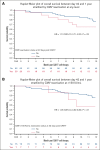Conflict-of-interest disclosure: E.K. reports advisory board participation with and received support for conferences from Merck. J.G. has served as ad hoc consultant and received honoraria from Sobi, Legend Biotech, Janssen, Kite Pharma, and MorphoSys; received research funding from Sobi, Juno Therapeutics (a Bristol Myers Squibb company), Celgene (a Bristol Myers Squibb company), and Angiocrine Bioscience; and participated in the independent data review committee for Century Therapeutics. M.S. has served as a consultant and participated in advisory boards, steering committees, or data safety monitoring committees for AbbVie, Genentech, AstraZeneca, Genmab, Janssen, BeiGene, Bristol Myers Squibb, MorphoSys/Incyte, Kite Pharma, Eli Lilly, Fate Therapeutics, Nurix, and Merck; received research funding from Mustang Bio, Genentech, AbbVie, BeiGene, AstraZeneca, Genmab, MorphoSys/Incyte, and Vincerx; has stock options in Koi Biotherapeutics; and reports employment with Bristol Myers Squibb (spouse). D.J.G. has served as an advisor and received research funding and royalties from Juno Therapeutics, a Bristol Myers Squibb company; served as an advisor and received research funding from Seattle Genetics, Janssen Biotech, and Bristol Myers Squibb; served as an advisor for GlaxoSmithKline, Celgene, Ensoma, and Legend Biotech; and received research funding from SpringWorks Therapeutics, Sanofi, and Cellectar Biosciences. M.J.B. has served as a consultant for Merck, Takeda, Symbio, Assembly Bio, AlloVir, and Moderna; received research funding from Merck and Moderna; and served as a consultant and had the option to acquire stock for Evrys Bio. J.A.H. has served as a consultant for Moderna, AlloVir, Gilead, Takeda, CSL Behring, and Karius, and received research funding from AlloVir, Gilead, Merck, and Takeda. The remaining authors declare no competing financial interests.




